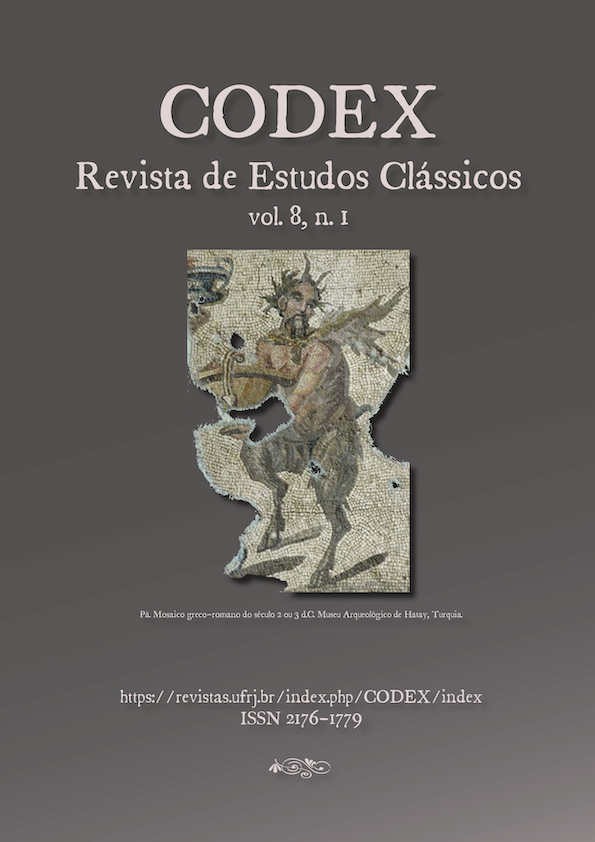The characterization of Medea through performance
DOI:
https://doi.org/10.25187/codex.v8i1.33633Keywords:
Euripides, Medea, Greek tragedy, characterization, performanceAbstract
Based on Taplin’s considerations about performance in The stagecraft of Aeschylus: the dramatic use of exits and entrances in Greek Tragedy (1997) and on Van Emde Boas’ studies on Euripides’ methods of characterization, as seen in Characterization in Ancient Greek literature (2017), this essay analyzes the Greek tragedy Medea to develop considerations on the character building of the protagonist as someone complex and multifaceted through her sequence of meetings during the drama.
Downloads
References
DINGEL, J. (1967) Das requisite in der griechischen Tragödie (Diss Tübingen).
GELLIE, G. (1988) The character of Medea. In BICS n. 35.1 pp.15-22.
GOULD, J.P. (2012 [1996]) Euripides. In Oxford Classical Dictionary, 4th ed., pp. 551-553. S. Hornblower, A. Spawforth, E. Eidinow (eds.). Oxford: Oxford University Press.
HALLERAN, M. (1985) Stagecraft in Euripides. Sidney: Croom Helm Australia Pty Ltd.
HAMILTON, R. (1987) Cries within and the tragic skene. In AJP 108: 585-99.
HARSH, P. W. (1965) A handbook of classical drama. Stanford University Press: Stanford.
MARTIN, R. P. (2007) Ancient theatre and performance culture. In The Cambridge companion to Greek and Roman theatre. McDonald, M. & Walton, J. M., pp. 36-54. Cambridge: Cambridge University Press.
MARTIN, R. P. (2002) Euripides: Medea. Cambridge: Cambridge University Press.
MASTRONARDE, D. J. (1990) Actors on high: the skene roof, the crane, and the gods in Attic drama. In Classical Antiquity 9 pp. 247-97.
MOSSMAN, J. (2011) Euripides: Medea. Oxford: Oxford University Press.
SEIDENSTICKER, B. (2008) Character and characterization in Greek tragedy. In Performance, iconography, reception: studies in honour of Oliver Taplin. Revermann, M., Wilson, P. 2008 pp. 333-346. Oxford: Oxford University Press.
SOURVINOU-INWOOD, C. (1997) Medea at a shifting distance: images and Euripidian tragedy. In Medea. Essays on Medea in myth, literature, philosophy, and art. Clauss, J. & Johnston, S. I., pp. 253-96. Princeton: Princeton University Press.
TAPLIN, O. (1977a) The stagecraft of Aeschylus: the dramatic use of exits and entrances in Greek Tragedy. Oxford: Oxford University Press.
TAPLIN, O. (1977b) Did Greek dramatists write stage instructions? In PCPS n. 23, pp. 121-32.
TAPLIN, O. (2006) The pictorial record. In Cambridge companion to Greek tragedy. 2nd. ed. Cambridge: Cambridge University Press.
VAN EMDE BOAS, E. (2017) Euripides. In Characterization in Ancient Greek literature. Leiden e Boston: Brill.
Downloads
Published
How to Cite
Issue
Section
License
This work is licensed under a Creative Commons Attribution-NonCommercial 4.0 International License.










